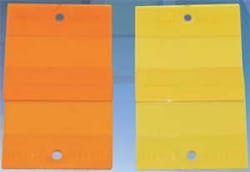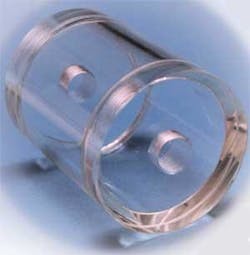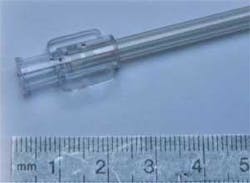New process allows plastics to absorb laser radiation and therefore be welded more efficiently
Laser beam welding of thermoplastic components has become a well-established processing method for a wide range of industrial applications. When using diode, Nd:YAG, or fiber lasers, the recognized procedure is transmission laser welding in the overlap configuration.1,2 The focused laser radiation passes through the transparent upper plastic part and is absorbed by the lower part, with the absorbed radiation being converted into heat at the interface, creating a joint, by heat conduction, with the upper part.
Natural or colored plastics have low absorption in the near-infrared (near-IR) spectrum. Carbon black, as a resin additive, is a very effective absorber over a broad wavelength field from visible to IR radiation to increase the absorption of plastics. However, when using carbon black, plastics are restricted to dark colors, and transparent plastic components are not applicable.
A process called Clearweld, developed with TWI Cambridge,3 enables transparent or colored plastics to efficiently absorb near-IR laser radiation. It is based on the deployment of special near-IR-absorbing materials used as coatings on the component’s surface or additives mixed into the resin of the lower part.4,5 These materials have low absorption in the visible range and high absorption in the near-IR from 800 to 1100 nm. Various absorber materials having relatively small bandwidth around the wavelength of maximum absorption are available to adapt the optical properties of the plastic to different wavelengths of commonly used near-IR lasers. In addition to the laser wavelength used, the best absorptive material is also dependent on further application requirements, such as process parameters, material properties, and the required color of the final part.6
Clearweld coating
Coatings that contain absorbers designed for use in the 940- to 1100-nm wavelength range are low viscosity, solvent-based liquids applied by various dispensing systems. Typical solvents used are based on ethanol and acetone. The amount of coating applied is measured in terms of nanoliters per square millimeter. The solvent is a carrier and is flashed off rapidly, leaving a thin film of absorbing material on the surface of the plastic. Typical drying times are between 1 and 7 s. It is possible to use assisted drying such as preheating of parts or postheating with an IR lamp to flash solvents off more quickly. Coatings can be applied offline.
When a coating is applied to a surface, a thin, uniform layer of absorber will be deposited. After drying, the coating has slight coloration in the visible range before laser exposure. To create the weld, the laser radiation is absorbed by the coating and simultaneously converted into heat. The material at the interface adjacent to the coating is heated and melted by heat conduction, and the weld is formed after solidification. During heating, the absorber decomposes and the coating loses visible coloration completely (see Fig. 1).
Additives
Absorbers also can be used in a broad range of thermoplastic materials as an additive in the lower plastic part to enable laser welding. This is similar to the use of carbon black, but with more flexibility of coloration in transparent or opaque plastic components.
Adapting the melting depth to the requirements of the application can be done with Clearweld absorbers by varying the absorber concentration in the resin. The absorber concentration is directly linked to the optical penetration depth, increasing concentration results in decreasing penetration depth and therefore in decreasing melting depth.
If a more extensive melting pool without the effect of thermal degradation of the polymeric material is needed for compensating gaps and geometrical tolerances, the absorber concentration can be set to lower values. If limited dimensions of the melting pool are needed, for example, in small contours on microfluidic devices, higher absorber concentrations can be used.
Custom-compounded resins containing Clearweld additives are designed for use with lasers in the 800-1100-nm wavelength. These resins can be injection-molded or extruded and can be color-matched with colorants during the compounding process to achieve a custom solution that meets the application requirements. The formulation requires a range of variables to be taken into account-polymer compatibility, color requirements, and laser welding wavelength.
Through successful color-matching, a transmissive top and absorptive bottom component can appear identical, while enabling optimization in the welding process on laser welded transparent yellow and orange sample plates (see Fig. 2). However, sometimes color requirements may determine the recommended laser wavelength and other welding parameters. Weldable resins with these additives can also be used for co-extrusion, insert molding, or to extrude films that can be die cut to be used as an intermediate layer for laser welding.
Welding oil reservoirs
A laser-welded oil reservoir made from transparent colorless pmma (see Fig. 3) is in semi-automated industrial production at Barkston Plastics Engineering.7 The production method used before laser welding was adhesive bonding, with extensive preparation of each component by mechanical cutting, excess trimming, and surface polishing. The flat top lid and bottom lid are welded to the central cylinder using a 940-nm diode laser.
Before welding, the Clearweld coating is applied to the edges of the cylinder, and after drying the components are assembled and clamped at the laser-welding station. The welding is done in one circular path, irradiating the focused laser beam from the top through the lid to the edge of the cylinder. During the process, the coating on the first edge is decomposed and enables the simultaneous welding of the bottom lid at the second edge of the cylinder. The laser beam is guided to the second edge by internal reflection on the walls of the cylinder. The laser welding results in fluid tight joints of high strength and outstanding optical appearance.
Simultaneous laser welding of the top and bottom lids to the cylinder using Clearweld coating leads to a noticeable reduction of production time with increased product quality by achieving hermetic seals and fully transparent product design. The production of the oil reservoirs can be done in economical small batch of 50 units per lot.
Welding medical tubes
Tubes for medical applications using additives to absorb the laser radiation were developed in cooperation with Natvar (see Fig. 4).8 Common joining methods for such devices are uv bonding or solvent bonding. uv bonding typically takes 15- to 20-s cure time. Solvent bonding is immediate but adds a chemical to generate the joint. uv and solvent need full surface contact for the entire length of the luer (tapered fitting), which can typically be 0.250 to 0.500 in. long.
These tubes are manufactured by co-extrusion of an inner and outer wall layer to meet the application demands of loadable tubes with a soft haptic (tactile) outside. The layers can be made from different plastics and thermoplastic elastomers such as pvc, tpu, tpe, or cope. The additive is placed in the outside layer of the tube wall where it is needed for enabling laser welding of luers to each end of a tube. Tubes and luers have to be transparent and colorless to allow the survey of liquids flowing through the tube.
The luer is fixed to the tube by a press fit and can be simultaneously laser welded using an adapted beam-shaping design to form a ring joint. Because of the press fit, no additional clamping will be needed. Positioned at the end of the tube, the laser weld will generate a hermetic seal without any change in the transparency of the components.
The main advantages of laser welding over uv and solvent bonding are that a mechanical bond is created that does not need additional solvents or adhesives. Compared with conventional methods, laser welding requires a 0.125-in. bond pocket for a mechanical bond that equals and exceeds the common bonding methods and takes less then 0.5 s for processing compared with 15- to 20-s cure time for uv bonding. Some applications require different bonds on each end of the tube set (solvent one end and uv the other). Laser weld will work for both ends, while solvent will not.
Transparent thermoplastic polymers and elastomers can be laser welded using near-IR absorbing material as a mechanism to produce heat and localized melting. The success of the technique has been demonstrated on several applications and shows the capability of Clearweld coating or additives to match the absorption properties of thermoplastics to enable these materials to be laser welded on an industrial scale. This laser welding process creates transparent colorless weld seams. The laser energy is absorbed only in the area where the weld has to be generated between the two interfaces of the components to be welded. Other areas will not absorb any radiation; thus, no additional thermal stress will be generated in the workpiece.
Using additives, high-quality joints can be achieved. Depending on the concentration of the absorber, the absorption of the radiation occurs deeper into the material than when using coatings. This generates higher volumes of molten material, which is more practical for compensating gaps and fit up tolerances.
Additives are well suited to molding colored transparent and colored opaque substrates for electronic housings, medical devices, fluid containers, and other relatively small components or components with large weld areas. With well adapted welding parameters, high visual quality and weld strength of the joints are achievable.
For new or enhanced plastic laser welding in the medical, electronic, automotive, textile, packaging, and consumer-goods markets, this technology empowers the engineer through clean, optically colorless joints, hermetic sealing, design flexibility, noncontact processing, no particulate generation with little or no flash, and no third body as with adhesives. In addition the additives and coatings are biocompatible.
R. Klein ([email protected]) is with Gentex Corporation (www.gentexcorp.com), Gross-Umstadt, Germany, and G. McGrath is with Gentex Corporation, Cambridge, UK. The authors are grateful for the assistance of Bob Donohue from Natvar, Tony Blackmore from Barkston Plastics Engineering, and the Clearweld group of Gentex in Carbondale.
References
- I. Jones, “Transmission Laser Welding of Plastics,” TWI Bulletin 75, 4 (July/August 1998).
- F. Bachmann and U. Russek, “Laser Welding of Polymers Using High Power Diode Lasers,” Proc. Photonics West (2002).
- I. Jones, N. Taylor, R. Sallavanti, and J. Griffith, “Use of Infrared Dyes for Transmission Laser Welding,” Proc. ANTEC 2000, 1166 (2000).
- S. Hartley and N. Woosman, “Welding of Infrared Transmissive Thermoplastic Polymer Using Diode Laser Systems,” Proc. LIM (2003).
- N. Woosman and R. Sallavanti, “Achievable Weld Strength for Various Thermoplastics Using the Clearweld Process,” Proc. ANTEC 2003 (2003).
- R. Klein and G. McGrath, “Creating Transparent Laser Weldings on Thermoplastic Components,” Joining Plastics 06 (2006).
- N. N.: Application Note B3, Barkston Plastic Engineering, Leeds, UK.
- N. N.: “Sure Bond” Laser Weld Tubing, product information sheet, www.natvar.com/product.html.



